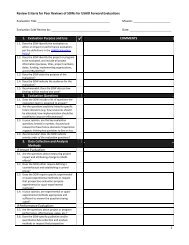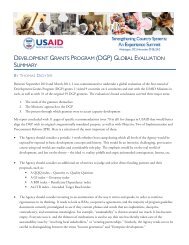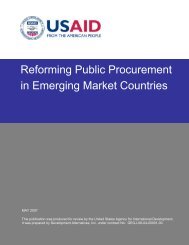Study on USAID Non-Project Assistance Programs in
Study on USAID Non-Project Assistance Programs in
Study on USAID Non-Project Assistance Programs in
Create successful ePaper yourself
Turn your PDF publications into a flip-book with our unique Google optimized e-Paper software.
Improvement <strong>Project</strong>. RHIP f<strong>in</strong>anced the recruitment, tra<strong>in</strong><strong>in</strong>g, and supervisi<strong>on</strong> of village health teams;tra<strong>in</strong><strong>in</strong>g of health cadres; and the c<strong>on</strong>structi<strong>on</strong>, repair, and equipment for rural health facilities. RHIP wasdesigned primarily to provide budgetary support to the primary health care (especially the village healthteam) program and there was little c<strong>on</strong>diti<strong>on</strong>ality associated with the provisi<strong>on</strong> of resources to theMOPHSA <strong>in</strong> its design.Despite the development of a large delivery system <strong>in</strong>frastructure and supportive health policies,a pre-NPA sector analysis c<strong>on</strong>ducted <strong>in</strong> 1986 identified significant weaknesses <strong>in</strong> the health care deliverysystem <strong>in</strong>clud<strong>in</strong>g:Inadequate management and plann<strong>in</strong>g, the lack of <strong>in</strong>tegrati<strong>on</strong> of ec<strong>on</strong>omic and f<strong>in</strong>ancialfactors <strong>in</strong>to health plans, and weak central adm<strong>in</strong>istrative structures and <strong>in</strong>stituti<strong>on</strong>s;An imbalance <strong>in</strong> the allocati<strong>on</strong> of funds between preventive and curative care pers<strong>on</strong>neland material, and between rural and urban populati<strong>on</strong>s relative to the stated objectives ofpromot<strong>in</strong>g primary and preventive care;A lack of <strong>in</strong>tegrati<strong>on</strong> of exist<strong>in</strong>g services and shortage of services <strong>in</strong> many areas;Inadequate support of pers<strong>on</strong>nel, <strong>in</strong>clud<strong>in</strong>g <strong>in</strong>-service tra<strong>in</strong><strong>in</strong>g, supervisi<strong>on</strong>, materials, andsupplies;Lack of health care f<strong>in</strong>anc<strong>in</strong>g policies that address the c<strong>on</strong>t<strong>in</strong>ued prospects for poor (oreven negative) growth <strong>in</strong> budgetary resources <strong>in</strong> the near future;Inefficient spend<strong>in</strong>g practices and an absence of cost c<strong>on</strong>ta<strong>in</strong>ment measures;Lack of an <strong>in</strong>tegrated nati<strong>on</strong>al health plan, comb<strong>in</strong>ed with the timely, reliable, andcomprehensive <strong>in</strong>formati<strong>on</strong> about services, resources, and the populati<strong>on</strong>’s health status.5.2.1 The Niger Health Sector Support Grant (NHSSG)In resp<strong>on</strong>se to the c<strong>on</strong>stra<strong>in</strong>ts identified by its analysis of the health sector <strong>in</strong> 1986, <strong>USAID</strong>designed and authorized the Niger Health Sector Support Grant (NHSSG) as an NPA program for thehealth sector. As the first health sector NPA program <strong>in</strong> Africa, it has the l<strong>on</strong>gest history of any of thehealth sector NPA programs funded under the DFA. Much of the design and mechanisms forimplementati<strong>on</strong> were modeled <strong>on</strong> <strong>USAID</strong>’s experiences with NPA <strong>in</strong> the agriculture sector <strong>in</strong> Niger.In 1986 the orig<strong>in</strong>al NHSSG grant agreement to provide $15 milli<strong>on</strong> to the health sector over afive-year period was signed. Release of $10.5 milli<strong>on</strong> <strong>in</strong> tranches over a five-year period was c<strong>on</strong>diti<strong>on</strong>edup<strong>on</strong> achievement of specified policy review and reform benchmarks ("c<strong>on</strong>diti<strong>on</strong>s precedent"). Therema<strong>in</strong><strong>in</strong>g $4.5 milli<strong>on</strong> was programmed <strong>in</strong> support of technical assistance and tra<strong>in</strong><strong>in</strong>g. An additi<strong>on</strong>al $2.2milli<strong>on</strong> for project assistance was added to that sum when the NHSSG was extended <strong>in</strong> 1990 (it has s<strong>in</strong>cebeen extended a sec<strong>on</strong>d time with completi<strong>on</strong> now scheduled <strong>in</strong> 1995).The NHSSG was designed to complement and be implemented <strong>in</strong> close collaborati<strong>on</strong> with otherd<strong>on</strong>or efforts <strong>in</strong> the sector. The most important area of collaborati<strong>on</strong> was the World Bank Health <strong>Project</strong>,which supports policy reform efforts of the Government of Niger undertaken as part of the StructuralAdjustment Credit program.12







